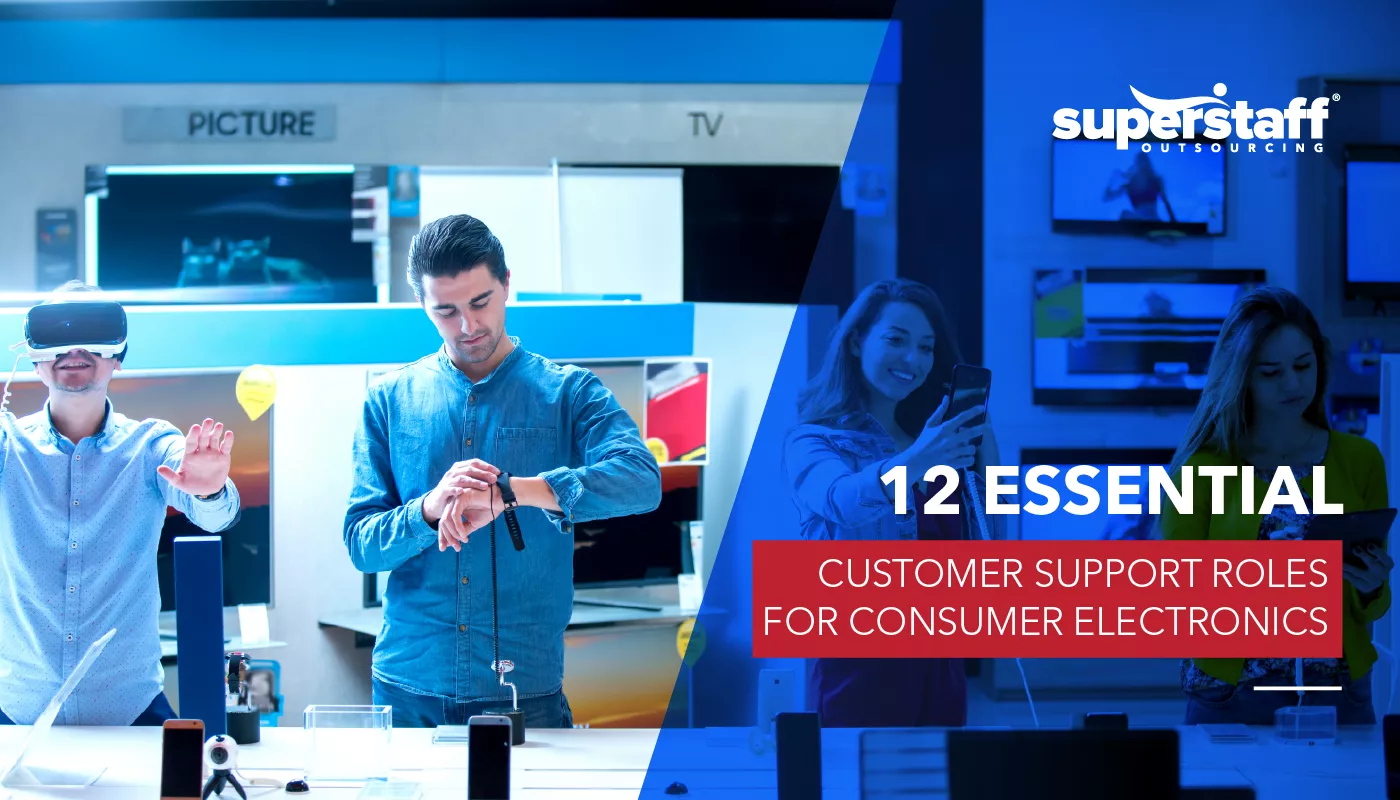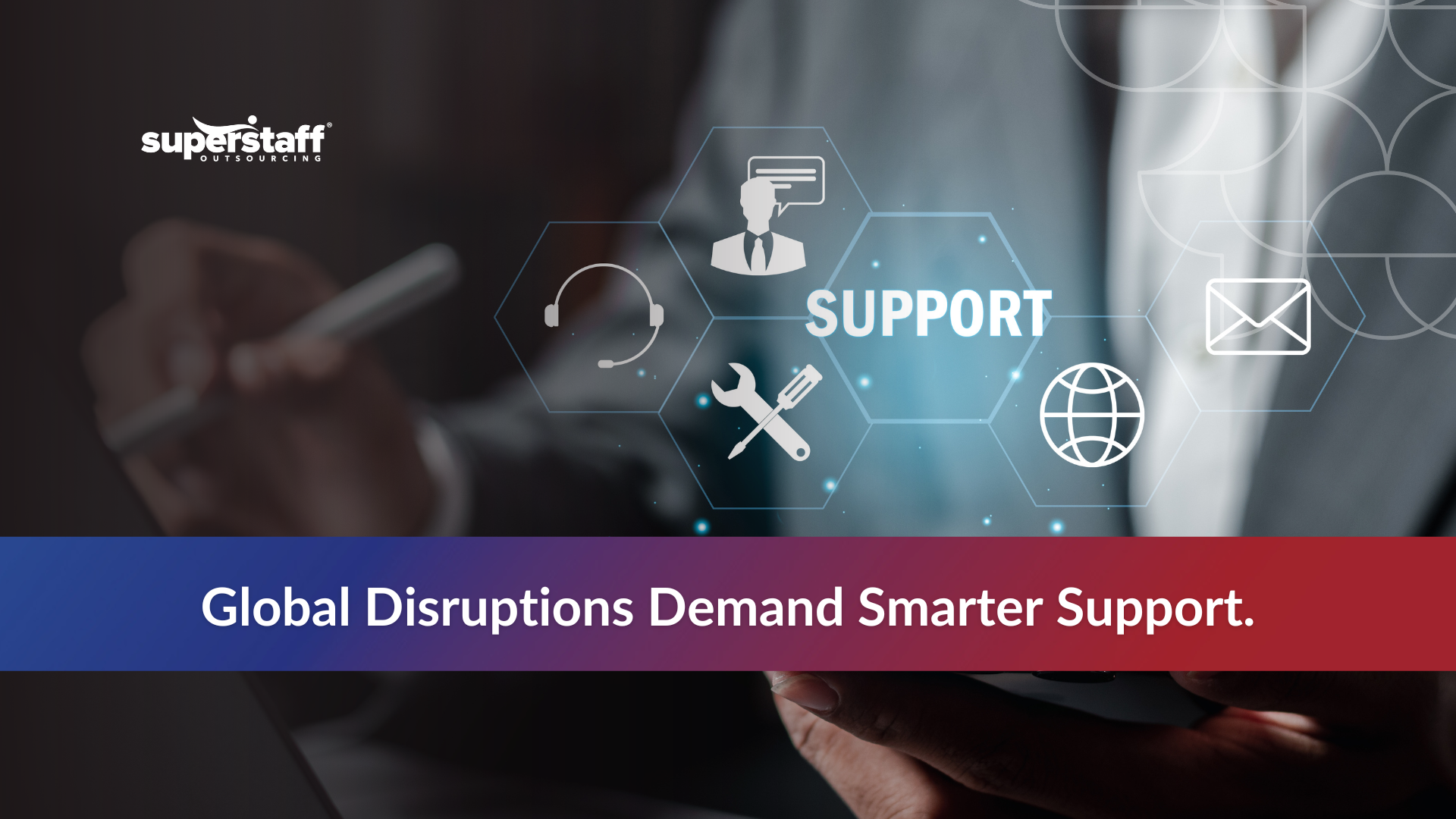
There’s one thing you should know about the consumer electronics industry: It’s constantly evolving. And today, electronic devices have come a long way, becoming more cutting-edge and highly diverse in functionality.
As more new and innovative devices are launched, many think the consumer electronics sector will reach saturation one day. But a recent forecast shows otherwise. In 2023, the market is projected to generate around $1.1 trillion, with more than 4% growth.
All consumer electronics companies should remember to balance the businesses’ product development side and the all-important customer-facing side. This aspect is where you require the help of consumer electronics customer support staff.
12 Consumer Electronics Customer Support Tasks You Can Outsource
Your customers are the reason that the consumer electronics industry has snowballed into a trillion-dollar market. Level up your customer service with these 12 call center solutions:

#1: Technical Support
No consumer electronics businesses can operate without technical support. As electronic products become more complex and sophisticated, customers require help navigating the functionalities. Otherwise, they are more likely to return products.
Take a look at this study conducted by TechSee in 2019:
- 54% of customers return a product if the installation process is complicated.
- 70% give it back if they find it difficult to use.
A technical support team educates customers on the product’s usability with step-by-step instructions, especially for those experiencing technical issues with computers, mobile phones, or other electronics. The specialists also resolve other IT-related complaints, such as setting up accounts or issues with constant internet disconnection.
There is a tiered staffing structure that strategically addresses customer needs at the right support level. Customer concerns are escalated to each tier if the current one they’re in offers no available solution.
Here are the various tiers:
- Tier 0: This level is mostly self-service and requires no direct interaction between the users and the support team. Instead, clients retrieve technical information and guidelines from FAQs, blogs, search functions, or manuals.
- Tier 1: At this stage, the technical team imparts basic-level technical help, like clearing up tickets on usage issues. Usually, the personnel reads from scripts to satisfy client requests.
- Tier 2: This support team is knowledgeable about the products and services but they are not necessarily the ones who created or designed them. The technicians evaluate more intricate issues escalated from Tier 1.
- Tier 3: Clients gain access to a team of highly skilled technicians such as creators, engineers, and product specialists. The goal is to tackle the root causes of their problems and maintain a database of new fixes. The database will then descend to Tier 1 and 2 and relay them to prospective customers.
Depending on the support level, technical support delivers services in many ways, including phone calls, live chat, email, chatbots, and other online tools. Companies are also in the pursuit of attending to customers 24/7 to provide services promptly.
Thus, providing round-the-clock technical assistance through various channels allow customers to contact you with any technical issues, from software bugs to product malfunctions. This availability offers several advantages, including improved customer satisfaction and greater control over potential product issues.
#2: Help Desk
Technical support and the help desk department are not the same.
Help desk support specialists focus on providing users with cost-effective solutions for surface-level problems, such as renewing passwords or application updates.
Ideally, companies integrate Customer Relationship Management into their help desk support. CRM lays out contextual details about end users. CRM implementation is critical as 72% expect companies to remember their prior purchases regardless of the means of interaction.
Since the help desk is a customer’s first contact, its main goal is to boost customer satisfaction by initiating communication. Usually, this team attends to complaints that are quickly resolved. On the other hand, the technical support team is in charge of more specialized issues that require a certain level of expertise.
When the questions received by the help desk are too technical and beyond its competence, the team escalates calls to the technical support department.
Help desk assists companies with two things: identifying specific problems and escalating them to the right person. With this, companies can effectively and promptly solve customer concerns without causing any unnecessary delay.
#3: Customer Service
Addressing technical issues is more than just a be-all-end-all. General inquiries, including rates, special deals, offers, and orders’ delivery status, are just as important. Here, customers’ emotional outbursts, annoyance, and anger become common. Worst, these issues usually result in customers being forwarded to different agents.
According to a 2020 study, repeating themselves multiple times is the third-most upsetting customer experience. Thankfully, a customer service team is an expert in First Contact Resolution (FCR).
On the other hand, when escalating calls up the chain of command is necessary, customer service agents are mindful of average handle time (AHT). A good AHT is when customer reps sort out client complaints in a reasonable time. So, depending on the issue, each customer’s calls, chats, or emails are handled efficiently.
Hiring a team of support staff for consumer electronics can be a game changer for your business. They implement the best customer service practices to retain loyal consumers and attract new ones. Moreover, they deliver quality work across all interacting platforms, making customer care their priority.
#4: Sales Support
The sales reps and sales support teams go hand in hand. The sales reps focus on helping customers find what they need. The sales support specialists ensure positive interactions with clients over time.
A two-fold objective is everlasting customer satisfaction and increasing positive word-of-mouth to generate leads. All in all, the primary goal is to reach the average sales quota. However, many times, companies neglect customer service as they pursue sales.
Take a look at these numbers:
- 23% of sales reps need more leads to hit the quota.
- 48% of sales leaders acknowledged needing more leads for sales agents.
There’s a clear-cut solution: onboarding a sales support agent team for consumer electronics.
The sales team should only wear a few hats. They should focus on closing more deals.
Any work that impedes engaging new prospects is delegated to the sales support team. Some of their tasks include providing customer service, tracking sales, and handling customer complaints.
Also, sales support has robust software to search and filter for qualified leads. That said, sales reps can save time picking and choosing which prospect is worth the call.
#5: Live Chat
Not all customers are comfortable with over-the-phone communication. That’s why buyers expect an alternative. This is where live chat becomes a company’s holy grail.
Live chat is a communication tool that connects a customer with a brand representative through instant messaging. Let’s take a look at the statistics:
- 43% opted for live chat support when raising complicated matters.
- In 2020, chat-based support requests rose by about 80%.
- About 73% found live chat the handiest way to interact with a business.
Most clients prefer live chat because it requires minimal effort to obtain instant responses. In June 2022, the average turnaround time for chat responses fell below 40 seconds, approximately 6 seconds faster than two years ago.
This makes live chat an effective tool when clients desire real-time and immediate assistance with technical issues but need help following verbal instructions. Tech support agents can also break down instructions bit by bit and go into greater detail when guiding customers through the process.
As a result, live chat is emerging as one of the top consumer electronics industry trends in customer support.
Not only that, it is projected to be hugely lucrative in the upcoming global market:
- The global live chat market will be valued at $987.3 million in 2023
- By 2030, it will be worth about $1.7 billion.
Adopting live chat in your customer care service can power up your customer’s experience by resolving your customer’s problems immediately.
#6: Email Marketing and Support
Note that there were 4 billion active email users worldwide in 2020 alone. That same year, over 306 billion emails were sent and received daily.
But by 2025, approximately 4.6 billion people will use emails and a whopping 376.4 billion circulation of emails. As we go, these digits will keep mounting. Knowing these estimates, it is wise for electronics companies to invest in email marketing and support.
Consumer electronics businesses can use email to promote new products and deals. As such, your audience becomes aware of your brand and services. Also, this is an opportunity to educate your consumers about your company.
However, it is critical that your email marketing remains high-quality and adheres to the best standards. Research shows that, on average, companies could receive $36 for every $1 spent on email marketing.
One way to measure the effectiveness of your email marketing is by looking at its click-to-open rate (CTOR), or the number of times people click to see your email. A survey says that people spend around 5 hours looking through personal or work emails. So, simply put, there’s a high chance that your audience reads promotional assets if you send them via email.
At the same time, consumer electronics companies need a dedicated email support crew to answer inquiries and customer feedback. This is because email is still one of the top platforms for clients to correspond with the customer care team. For simple information requests — such as shipping status or information updates — most customers prefer email (60%) over other digital channels.
For a more streamlined customer experience, you can hire a consumer electronics customer support team to clear out piled emails. While doing so, you can also attract more customers using the right email marketing tools.
#7: SMS Support
Quick, cost-effective, and simple — these are the qualities that have made SMS a long-time favorite for many phone users.
Short Message Service Support, or SMS Support, involves a linear interaction where the client and customer care rep converse without being present. In SMS support, texting is the most common activity.
As the consumer industry rises to fame and success, the audience expects brands to establish text support. Let’s jump into the stats to understand why this type of support is becoming increasingly important:
- 6.65 billion people will own smartphones in 2022 alone.
- Around 76% use smartphones to chat and text.
- Text messaging is the preferred channel for 24% of clients.
Given that, brands should capitalize on SMS support. A survey reveals that 27% view customer experience as “bad” if they cannot use their preferred communication mode.
So, outsourcing a customer care team will do the trick if you’re looking to leverage the SMS support feature for your consumer electronics business. A SMS support team helps your clients gain a positive perception of your brand via mobile messaging.
#8: Mobile App Support
Brands should always ensure that customer service is top-notch. That’s why most of them develop mobile apps to beat competition.
In 2021, 2 million apps were released mainstream. People dedicate most of their time to researching, shopping, and surfing mobile apps for products.
Brands need to compete for users’ attention. With that, customer support should always be a priority.
However, some brands commit mistakes as follow:
- 49% of customers felt that companies tend to abandon in-app customer support.
- 54% say apps failed to include built-in customer support.
- 71% defect to a competing app/product after a bad experience or if mobile apps are more of an inconvenience.
To sum up, mobile apps cannot thrive without customer support. Not investing in app-based customer service could even affect other aspects of the business, such as advertising and app development.
If you’re a small to medium-sized business, building a mobile app support team should be one of your main considerations. Because in the long run, it can add tremendous value to your brand. Ultimately, it cultivates customer retention and loyalty:
- 86% stick to a brand that delivers a good in-app customer experience.
At all times, app customer support helps clients solve issues and provides guidance on product functionalities. For that reason, opting to outsource a consumer electronics customer staff team is your best call.
#9: Social Media Support
Social media applications are more than just apps for leisure, marketing, and advertising. They now serve as customer care channels. In fact, 33% of Americans use social media to convey dissatisfaction with a brand or customer service.
Whether on Facebook, Twitter, or Instagram, agents can connect with clients to answer questions and resolve problems immediately. This digital strategy is effective for users as they can reach out to your CS team on preferred channels.
According to a report, about 60% of clients agree that part of providing good customer support is a quick resolution to customer complaints. That alone fortifies how special social media customer care is in allowing for a near-instant response.
Usually, a customer rep on social media responds to Tweets, Facebook chats, and Instagram comments. They also observe social listening by assessing public conversations online about your company and your industry.
Here are some numbers you must know:
- 54% of clients prefer companies replying to customer service-related questions on social media.
- Failure to address or field comments on social media may lead to a 15% rise in churn rate.
- 92% of clients avoid a business based on negative comments.
Your outsourced consumer electronics customer support team minimizes these risks. They go beyond the “common” social media channels. So as you know, some customers are more active on less-paraded platforms like Pinterest or Snapchat.
Additionally, social media support organizes questions and complaints as follow:
- Technical or account-related concerns
- Comments from dissatisfied users
- Problems that may lead to a PR crisis
Comments listed as second priorities have little to no urgency, but provide an opportunity for you to be proactive in:
- Addressing general mentions of your products
- Expressing your gratitude to those who give good feedback
- Appreciating those who leave comments about your brand
#10: Data Entry
Major players in the consumer electronics industry often strive to serve customers’ needs and wants. And high-end data processing can help in obtaining and organizing information about customers and how they respond to products and services.
Mere raw data is primarily useless for businesses, but it can be a powerful tool in the right hands. Through data processing, raw data can be used to reveal valuable information.
Organizations can make informed decisions and forecast future trends with better accuracy. Hiring data entry specialists can help in this regard.
With accurate, well-organized, and reliable data, specialists can provide consumer electronics businesses with guidelines on customers’ current demands. They maintain database integrity which helps business owners raise time-to-market responses.
Let’s take a look at these stats:
- 62% of business leaders agree that personalization efforts enhance customer retention.
- 56% of clients become recurring buyers after a personalized experience.
- 80% of business owners say that customers spend 38% more after a more personalized experience.
The growing competitiveness in the business landscape urges companies to be strategic. The electronic industry needs to adopt a customer data platform to segment clients and provide targeted experiences to customers.
It’s apparent that customer support and data entry are closely knitted; one cannot prosper without the other. Outsourcing consumer electronics customer support members allows electronics businesses to access true experts in this field.
#11: Back-Office Support
There are many customer support tasks. And the customer-facing work is just one layer. Another includes back-office services.
Back office support reps secure records, manage data, organize accounting and finances, and keep track of technology changes, to name a few. Without this back-end support, the front office won’t function.
In the consumer electronics industry, back-office support professionals can include:
- Supply Chain Management Specialists: These specialists handle logistics customer support and ensure products are delivered on time. They also manage procurement jobs, which include planning raw materials, searching for suitable suppliers, and buying these items at an ideal rate.
- Accountants and Bookkeepers: They’re responsible for preparing and organizing financial statements, ensuring that the company’s finances are in order.
- Digital Marketers: Experts in this field create content for the brand’s website and social media pages and advertise new products and deals. Their main goal is to connect with current and potential customers in the online realm.
To ensure the efficiency of your operations, integrating these different departments into an ecosystem is crucial. Essentially, a back-office support team implements enterprise resource planning (ERP) to merge all back-end functions to streamline end-to-end processes and minimize waste.
By then, all information collected will become instantly available to those who acquire the right to use them. Further, you can generate reports to view the progress and performance of each department.
Here are the advantages of adopting the ERP:
- Bring down fixed costs by 20-30%.
- Speed up delivery to promise by 20%.
- Improve customer satisfaction by 5-10%.
- Increase business revenues by 3-5%.
Back-end work is the backbone of customer service. By hiring consumer electronics customer support, they’d ensure you’re prepared when dealing directly with customers.
#12: Multilingual Support
Global diversification is challenging if your company only speaks one language.
In 2020, a study showed that out of 29 countries, 75% of consumers are more likely to buy from brands if customer service is in their vernacular. Only a mere 40% will browse websites in foreign languages.
There is also pressure for U.S.-based companies to build multilingual support for their diverse clients. Here’s why:
- 25 million Americans cannot speak English.
- 90% of business leaders rely on multilingual employees.
- The need for workers to speak languages aside from English is growing in importance, especially for Spanish, Chinese, and French.
These studies show that the ability to interact in a client’s preferred language has become necessary for companies. Complete dependence on English-only speakers will not only repel many customers but also knock the opportunity to conduct business at a higher level.
Businesses should understand that it can be difficult for some customers to express concerns in English, especially if it’s not their first language. Offering multilingual support allows businesses to become better listeners.
At the same time, clients become more comfortable sharing experiences, which can increase customer satisfaction. This is especially important for consumer electronics businesses that cater to clients around the globe.
Outsource a team of trustworthy consumer electronics client support staff that can communicate in your customer’s language. With their multilingual capabilities, they can foster a deep connection with your customers and bridge cultural gaps.
Choosing Your Ideal Call Center Location
Nearshore Customer Support
Lately, nearshoring has become increasingly popular among companies in the U.S. Instead of limiting customer service workforce to in-house they opt for nearshore call center outsourcing in Colombia.
The nearshoring solution meshes the cost-effective measure offered by offshore call centers with the benefit of onboarding a CS team from a neighboring country.
Because of proximity, the time zone poses little to no issues to nearshore call centers in Colombia. They might even work in the same time zone as you without requiring any clock adjustments. Because of this, scheduling meetings and calls is not a hassle, enabling better accessibility of interaction and collaboration in real-time.
In addition, nearshoring in Colombia is also cost-efficient. In terms of traveling, you’re not only benefiting from its convenience but also the cost of it. You can strike down many of your expenditures for the workforce aspect and delegate them to other parts that matter more to your company.
If these benefits are what you’re looking for when outsourcing call center agents, then the Colombian nearshore solution is a perfect fit for your business.
Offshore Customer Support
U.S. enterprises have established immense trust in BPO providers in the Philippines. From its competent labor market to economic efficiency, it’s no wonder American businesses have become recurring clients.
If there’s anything the Philippines is known for, it is the world’s capital for call centers. That’s why many businesses rely on customer service in the Philippines.
The 2022 English Proficiency Index even ranked the Philippines 22nd globally. This makes the Philippines the home to a massive pool of talents who possess high proficiency in English. English is one of the national languages in the Philippines. Hence, the communication between agents and customers is more effective without misunderstandings.
Additionally, the BPO industry in the country is continuously evolving, making the Philippines a hotspot for qualified candidates who offer excellent customer service skills. On top of that, the customer care industry is embracing the advancement of technology by allowing customers to reach out to businesses via the online platforms they’re currently using.
And you can secure this entire package at a cost-efficient rate — without sacrificing the quality of service delivery.
Other than that, Filipinos are familiar with Western cultures. Because of this, they can easily relate to international clients. Coupling this with hospitality and courteous culture can spur higher customer satisfaction and happiness, making the Philippines the ideal destination for customer care outsourcing.
Outsourcing Consumer Electronics Customer Support Services in the Philippines and Colombia
Businesses can only thrive with an excellent customer service department. Especially for an ever-developing industry like consumer electronics, business owners can’t afford to play it safe. Instead, they should push boundaries by reinventing their business strategy and getting a reliable customer care team on board.
Outsourcing consumer electronics customer support is an ideal solution to propel the tech industry forward. Being well-trained and highly qualified, they can take on any customer-related issues and deal with them professionally and gracefully. Reach out to us today and learn more about how you can be at the forefront of the consumer electronics industry.






